14 Tips For Making Crispier Homemade French Fries, According To The Pros
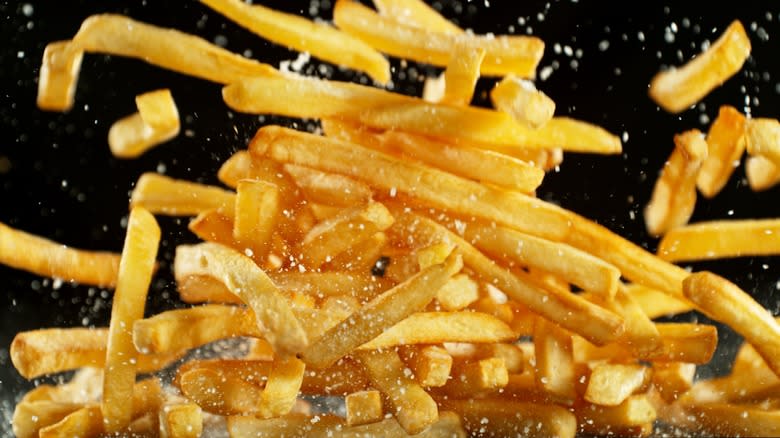
For many people, the perfect french fry is the holy grail of food. Whether you're making poutine from regular straight-cut french fries, constructing a bowl of loaded fries from a waffle-cut variety, or experimenting by trying out some different fries styles, the ideal french fry is crispy on the outside, and soft and steamy within. But getting a supreme crunch on your homemade french fries can be trickier than it looks.
A crispy outside is formed on french fries, or any other deep-fried food item when the heat from the oil simultaneously creates a crust on the outside of the food and forces the water inside it to evaporate. Getting this right every time might be easy for professional chefs, who have long understood that executing the perfect french fry requires careful preparation of the potatoes, the right oil at the right temperature, and careful control of the frying process. For home chefs, though, it can be much harder. So why not learn from the best? For this article, we scoured the internet for the best tips supplied by some of the most well-known professional chefs out there, to demonstrate that you can make the best French fries ever in your very own kitchen, even without a deep fryer.
Read more: French Cooking Tricks You Need In Your Life
Ensure You're Using The Right Type Of Potato
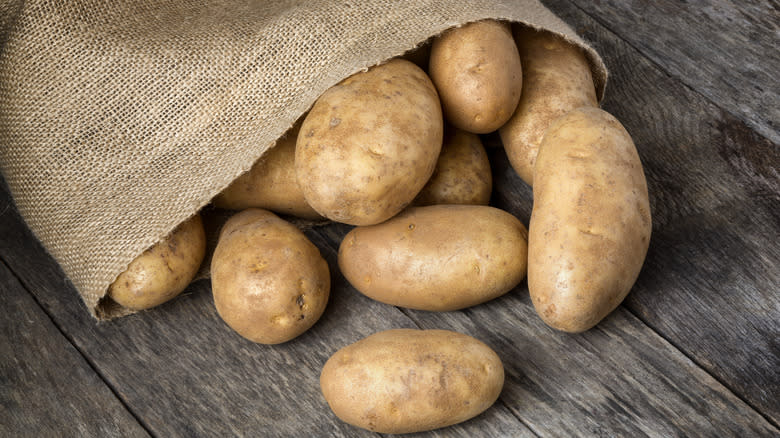
There are a massive amount of different potato varieties out there, and they all come in slightly different shapes, sizes, and flavors. And crucially, not all of them are the best option for french fries. Potatoes are primarily made from water, with their solid bulk being mainly supplied by starch. The more water a potato has, the longer it will take for the water inside to dehydrate when frying, and as a result, there's a higher chance that your french fries will be moist and limp.
That's why professional chef Frank Proto suggests going for Russet potatoes. "Potatoes like a Russet have a higher starch content, which means less water. Less water content, more starch, equals crispier fries," he explains via YouTube. Russet potatoes also have the perfect oblong shape, which gives you a lengthy canvas to work with and allows you to make super-long, thin fries.
If you can't find any Russets in the store, Idaho potatoes are your next best bet, as they also have a high starch content. Yukon Gold potatoes can also be an excellent option. On the other hand, you should always avoid waxy potatoes like the Red Bliss variety, or fingerling or new potatoes, as they'll be way too moist.
Use Potatoes That Are Slightly Older
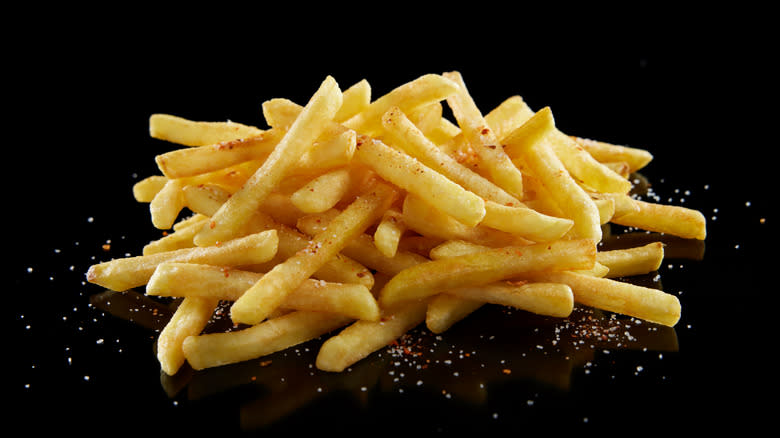
Potatoes can last for several months when stored in a cool, dark, dry place, so there's little rush to use them up. And if you have some potatoes that have been lurking in the back of your pantry for a while, you should take comfort not only in the fact that they're still edible, but that they make the perfect french fry. We actually cellar age our potatoes. Some magic happens with the sugars and starches as they age, resulting in the crispiest fry," reveals Saus owner Tanya Walker, per EatingWell. As well as the change in their sugar and starch composition, as potatoes get older they also lose moisture, due to the fact that they naturally dehydrate as time goes on. This leads to a higher starch ratio, and less water to contend with as they fry.
Walker opts for older Idaho potatoes in her restaurant, but any slightly older starchy potato should work just as well. Bear in mind that there's a fine line between a potato that's old and a potato that's too old. If your potato feels soft or mushy to the touch, has any visible mold or spoilage, or smells musty or rotten, you should throw it out immediately.
Cut Them Into Uniform Pieces
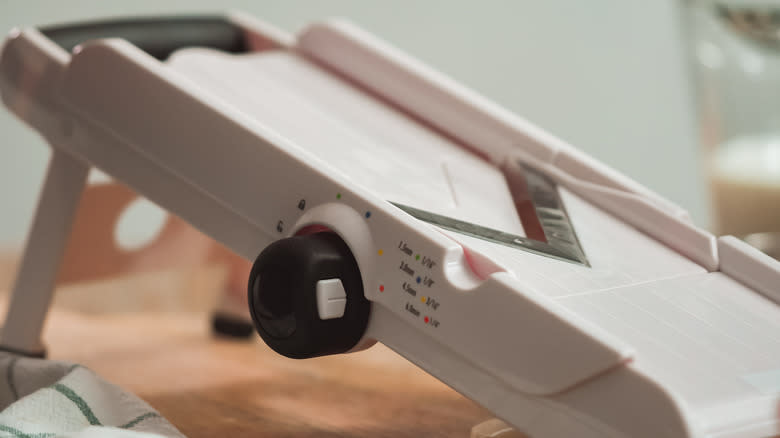
When you're making french fries at home, you have a huge amount of control over the shape you go for. But whether you're opting for thicker fries or a shoestring cut, they should be uniform. "If you're cutting them by hand, make sure they're all a consistent size," states the Idaho Potato Commission's chef consultant Adam Moore via Woman's World. "Bigger pieces cook slower than smaller ones, even when you're cutting as thin as a julienne strip." This difference in cooking time means that some of your potatoes will be done while the others remain soft and partially raw, and you'll never get an even, crispy cook on all of them.
Moore advises aiming for an ⅛ inch thickness on your potatoes. The potatoes should also not be too flat or thick, and should ideally be an even rectangle. Naturally, it can be pretty cumbersome to do this by hand and measure out each one. That's why chef Frank Proto uses a mandolin. These pieces of kitchen equipment allow you to slice potatoes quickly and evenly, and many models allow you to adjust the thickness of your slices to get exactly the right thickness. Be careful when you're using a mandolin, though, as it can be easy to cut your hands inadvertently, especially when you get down to the end of the potato; Proto suggests using a tea towel to hold the potato at this stage.
Soak Your Fries In Water Before Cooking

Potatoes can be full of starch -- and this is the greatest enemy of a crispy french fry. When your fries are too starch-heavy, that starch content gets in the way of the water evaporating when you cook your potatoes. This evaporation is what makes your fries so crispy, as the potato basically dehydrates in the hot oil, giving you a crunchy fry. Starch is especially a problem when it's on the outer layers or surface of your fries, as it basically locks the water inside the fry.
Interestingly, though, the solution to removing the starch to allow the water out is by using more water. Once you've peeled your potatoes, place them in a bowl full of cold water, and leave them in the fridge for eight hours, explains executive chef Riad Nasr, via the New York Times. Then, after you've done this, slice your potatoes into their fry shapes, and soak them again for eight more hours in a fresh bowl of water. This double-soaking method might sound strange, but Nasr explains that it works to draw the excess starch out of your potatoes. Thus, when you come to cook them, there will be less starch to block the water coming out, and they'll get extra crispy.
Use An Oil With A High Smoke Point
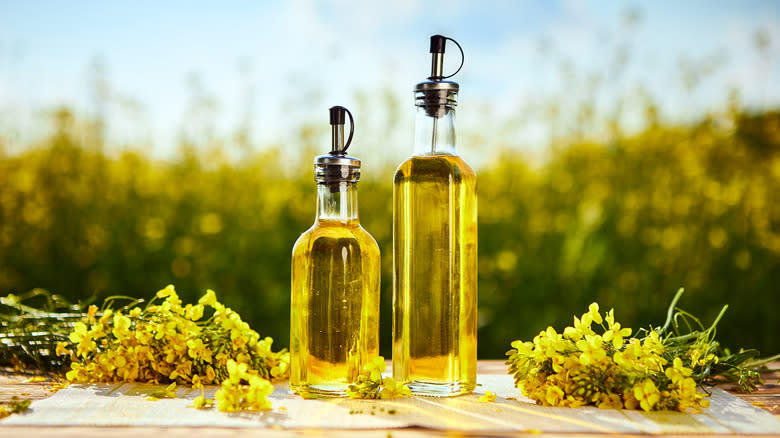
French fries are, in their most basic form, a simple marriage of potatoes and hot oil. And if you don't pick the right oil, with a high smoke point, half of the equation will be seriously off-kilter. "When you fry, you should use an oil that has a high smoke point," says chef Frank Proto, per YouTube. "We're not really ever gonna go over 375, 400 [degrees F], but we don't want the oil to break down in the process. We wanna keep those nice flavors." When oil that's not equipped for high temperatures breaks down, the smoke it releases can give food a nasty burnt taste and will fill your kitchen with acrid fumes.
Proto lists several types of oil you can use, all of which are pretty readily available. Standard vegetable oil has a smoke point of about 400 degrees Fahrenheit and is a good option, as are canola oil and peanut oil. Proto's personal choice, however, is duck fat. Duck fat has a rich, slightly buttery taste, which gives your fries a luxurious flavor, and its high smoke point of 375 degrees Fahrenheit keeps it stable when frying. Understandably, though, duck fat can be slightly more expensive than other oils, and easier-to-find vegetable-based oils work just as well.
Blanch Them In Oil First

The key to cooking restaurant-quality french fries at home is not to just cook them once, but twice. This is a method championed by none other than Gordon Ramsay himself, in a process known as "oil-blanching." Once his fries are ready to cook, Ramsay starts them off by frying them at 330 degrees Fahrenheit for two minutes. After he pulls them out and lets them rest, with the excess oil draining off the potatoes, he turns up the heat, submerges them in the oil again, and allows them to cook the rest of the way.
Blanching the potatoes in this manner has several advantages over just cooking them once. The first is that they crisp up better, as the initial blanch causes the surface starch on the potato to gelatinize, which ultimately means there's less starch in the final fry, making them crunchier. Blanching fries also sets their color, stopping them from going pale or browning too much when they're next cooked. Curiously, too, while you might not think that submerging them in oil twice is the healthiest thing in the world, it actually results in a french fry that's lower in fat. Because the outside of the fry begins to set, the barrier that's formed stops the oil from seeping into the potato as much, and it also reduces the amount of time the fry spends in the fat.
Cook Them At The Right Temperature
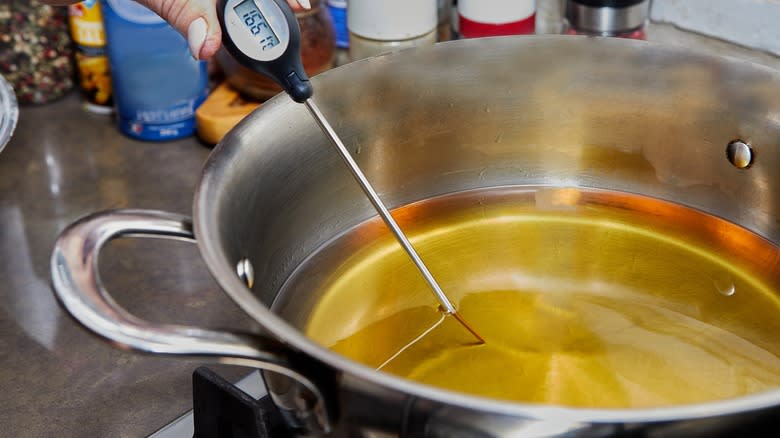
When cooking french fries, it's all about the temperature. And whether you're opting for a single-fry, double-fry, or even triple-frying process, you need to make sure you're being very specific. Use oil that's too hot, and your fries will burn on the outside before they're cooked through. Oil that's too cold, conversely, will leave your fries drenched in oil and totally undercooked.
If you're oil-blanching your fries, first set your temperature anywhere between 275 F, as chef Jean-Pierre Brehier does, to 330 degrees. Your second frying temperature should be set at around 375 to 400 F. If you have an at-home deep fryer, achieving this can be as simple as setting the temperature and waiting. If you're using a pot filled with oil, heated on a stove, it can be harder to know exactly when your fat is the right heat. Brehier favors using a clip-on thermometer, attached to the side of his pan, to keep an eye on the temperature. It's also useful to use a pot that you know conducts and retains heat well, to minimize the risk of cold spots in the pan leaving your fries patchily-cooked.
Pat Your Fries At Every Stage

Making french fries is a hands-on process, which starts from the moment you pick up your first potato. And it doesn't stop there. French fries should be constantly patted with a kitchen towel as you're preparing them to ensure maximum crispiness, and to remove anything that could get in the way of them cooking.
The first pat should occur once you've pulled your fries out of their water bath, to remove any moisture on their surface, as well as any excess starch that's lingering on them too. It can also be a good idea to place them on a tray lined with a kitchen towel, as chef Jean-Pierre Brehier does. Removing as much water as possible helps to prevent them from getting soggy when they cook and reduces oil splatter when they're placed in your pan.
Your second pat comes after you've blanched your fries in oil. In this instance, patting them with a kitchen towel gets rid of any excess oil on their surface, which stops them from becoming greasy or carrying too much fat. Here, though, make sure that you've allowed them to cool a little before you pat them, as otherwise you'll burn your hands.
Grab A Spider

Unless you have a deep fryer at home, it's tricky to know which utensil to use to fish your fries out. Items made of plastic may not be able to withstand the temperature of the oil and can soften and melt. Metal spoons, meanwhile, will carry too much of the oil out with them, while using forks or dinner spoons to fish out your fries runs the risk of you burning your hands.
The solution, courtesy of chef Frank Proto, is a spider. This utensil is a cross between a spoon and a strainer, with its base usually made of thin metal wire bound together on the end of a long handle. Spiders are perfect for making fries as they allow the oil to drain away as you fish out your fries, and their large surface area means you can scoop them all up in one go. Spiders are also useful as you can use them to stir the fries when they're in the oil, which ensures that they cook evenly on all sides. Spiders are also super-cheap, and you can pick them up in stores for just a few bucks.
Between Cooking Stages, Freeze Your Fries

As cooking crispy french fries requires a lot of heat, it feels a bit strange to reduce that heat to freezing halfway through the process. But that's exactly what chef Jean-Pierre Brehier does. After Brehier cooks his fries for the first time by oil-blanching them, he then puts them on a metal tray, patting them dry with a kitchen towel. He then places the tray in the freezer, for 2-3 hours, before pulling them out and placing them in hot oil.
The reason Brehier does this is to transform the structure of the french fry. By placing the fries in the freezer, you allow ice crystals to form inside them. These crystals puncture the interior structure of the potato and soften things up on the inside. While that might seem like a bad thing, what happens when you cook them again is that the inside becomes fluffy and soft, without having to cook them for too long on the outside. This results in a perfectly-crisp exterior, that doesn't end up too brown or burnt. If you don't have space in your freezer, Brehier states that you can put them in your fridge instead. Just bear in mind that you will need to allow more time for them to cool down completely.
For The Crispiest Result, Triple-Cook Your Fries
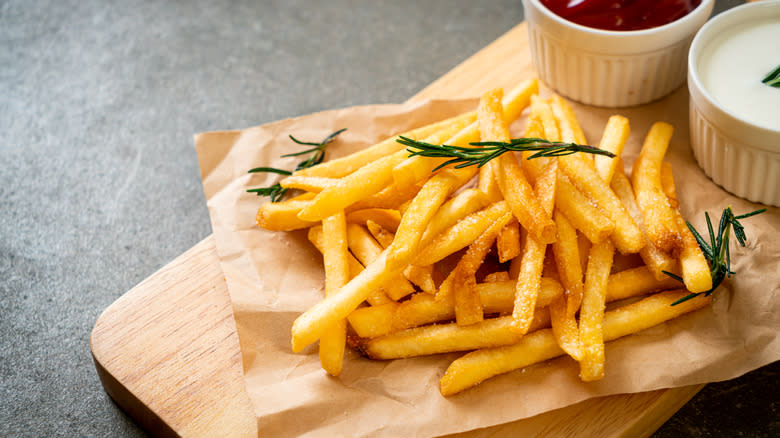
A lot of people know that double-cooking fries is an excellent way to make them crispy. But taking it one step further can give you a crunch beyond compare. Triple-cooked french fries are a favorite of British chef Heston Blumenthal, whose scientific method takes a little work, but produces uniquely crispy results.
Before his fries even reach the oil, Blumenthal first simmers them in water for 20-30 minutes, until they're just cooked through and are starting to lose their structural integrity. This slight breakdown causes the fries to crack slightly, giving the oil more nooks and crannies to create crispiness. He then freezes the potatoes, which wicks away moisture, before oil-blanching them at roughly 270 degrees Fahrenheit. Following this, the fries are then frozen again to remove more moisture, before getting a final fry at 356 F.
This repeated frying-and-freezing process has the effect of getting rid of as much water as possible in the potato, while simultaneously keeping it soft on the inside. The result is a fry that's as brittle as a cracker and oily without being greasy. There's no denying, though, that this method takes a lot of effort.
Season Them Immediately
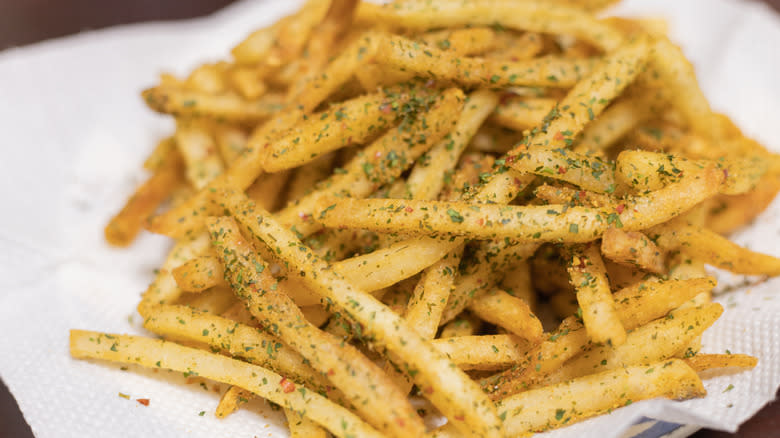
No one likes an underseasoned french fry, and when you season them makes not only a difference to their flavor but their crunchiness too. Chef Frank Proto recommends seasoning them as soon as they come out of the fryer when they're still hot. To do this, he places them in a metal bowl and hits them with some fine sea salt, which gives the fries better coverage. Flaky salt has a harder time sticking to the fries and will tend to collect at the bottom of the bowl.
When you season your fries immediately, the hot oil on the outside of the fries helps your salt and any other flavor additions stick to them better. But it also means that you're not waiting around. If you're waiting to season your fries, you're giving them way more time to cool down and become soft; The pipeline from oil, to seasoning bowl, to plate, should be a rapid one.
The only time you should wait to season your fries is when you're adding wet seasonings like vinegar. In these situations, you should wait until your fries are on the plate before adding them, so that you're not adding moisture too early on.
Serve Them With Space

You've spent hours constructing the best french fries you've ever made, only for them to turn soggy the moment they hit the bowl. What gives? It's likely that you're bunching them up way too much. "If they are all clumped together, they're going to steam together, which makes for soggy french fries," states chef consultant Adam Moore, per Woman's World. Your fries will carry residual heat with them onto the plate, and this heat will gradually slacken the potatoes if it doesn't have anywhere to escape.
You can avoid this by serving your fries on a wide dish or plate, trying to avoid stacking them on top of each other too much. It can also be helpful to place a layer of paper towel under the fries, which will help to capture any extra moisture, which otherwise will go into the fries themselves. Paper towels will also soak up any extra oil that drips off the fries, preventing it from pooling at the bottom of the plate. Try to avoid using a serving bowl that's too deep, as the moist heat will get trapped inside, leaving you with moist potatoes.
For Lighter Crispy French Fries, Bake Them With Cornstarch

Most people assume that achieving crispy french fries can only be done with a lot of oil and heat. But it's entirely possible to get super-crispy fries in the oven too, thanks to chef Lan Lam's method. She does this by using a combination of a moderate amount of oil, some cooking spray, and some cornstarch. Lam begins by spraying a baking sheet with cooking spray, and then adding some oil to the tray. "What we're doing here isn't just preventing the fries from sticking," Lam says via YouTube. "The cooking spray's gonna help the spray stay spread out across the surface of the pan, and that's how we ensure that every fry has just that right amount of flavor."
Lam then makes a cornstarch slurry by combining it with water and then microwaving it, creating a thick, pudding-like liquid. After coating her fries with the cornstarch mixture, she then bakes them covered in foil, allowing them to steam, before finishing them off in the oven uncovered. As the fries cook, the cornstarch turns crispy, which gives the potatoes a crunchy coating without any deep-frying required. Lam's method is an excellent one for folks who might be a bit wary of deep frying, or who might want to simply make a lighter version of fries that still have loads of crunch.
Read the original article on Daily Meal.

